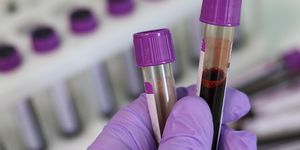Circulating tumor cells are tumor cells found circulating in the blood that come from a primary tumor. Circulating tumor cells have utility in clinical applications, including genomic analysis of cancer cells and monitoring the progression or recurrence of cancer. Since circulating tumor cells are usually collected through a blood sample, this method is relatively noninvasive compared with traditional tissue biopsies.
Research presented at the San Antonio Breast Cancer Symposium (held December 6-10, 2022) suggests that a count of circulating tumor cells could help clinicians decide between chemotherapy and endocrine therapy as first-line treatment for certain types of breast cancer.
Using circulating tumor cell (CTC) count to decide between first-line treatments provided an overall survival benefit for patients with metastatic, estrogen receptor (ER)-positive/HER2-negative breast cancer when compared to the physician’s choice of treatment.
Study presenter François-Clément Bidard, MD, Ph.D., and professor of medical oncology at Institut Curie and Versailles Saint-Quentin University, said that “we hypothesized that the CTC count could drive and help standardize the difficult treatment decision between endocrine therapy, which appears more suited for patients with good prognosis, and chemotherapy, which may benefit patients with worse prognosis.”
Since endocrine therapy options typically have fewer side effects than chemotherapy, the consensus among experts is to exhaust all endocrine therapy options before switching to chemotherapy. Despite the consensus, treatment decisions vary widely between physicians and treatment centers.
Bidard and the other researchers involved in the study designed a trial in which 755 patients were randomly assigned to either have their treatment decided by a clinician or by their CTC count. Primary results showed a survival benefit in patients whose treatment was escalated to chemotherapy based on their CTC count. Nearly five years after the trial began, study participants continue to have better long-term outcomes.
“The STIC CTC trial is the first to establish the clinical utility of the CTC count as a biomarker in breast cancer care, indicating that a single assessment of the CTC count before the start of treatment can guide the treatment decision between chemotherapy and single agent endocrine therapy,” said Bidard. “Our study demonstrates that integrating prognostic biomarkers into the treatment algorithm can improve the management and outcomes of metastatic breast cancer patients.”
Sources: Nature, San Antonio Breast Cancer Symposium



